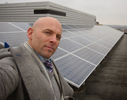
08 Oct The Future of Solar
As solar power continues to grow in popularity, it’s important to plan for the future. We asked eight leaders in the field of solar energy to weigh in on upcoming developments and challenges for the industry. What is the future of solar? Here’s what the professionals had to say.
“Photovoltaic technology has been around for over half a century, and although the price has fallen dramatically, and efficiencies have improved, decades later we still employ the same PV panels you see installed on rooftops, landfills, and parking canopies. These panels have inherent constraints for those looking to reduce their carbon footprint – urban dwellers find it difficult to identify suitable locations for PV, while suburbanites can be challenged by older roofs or shading from trees or other structures, and rural communities express increasing sensitivity to proposals for large-scale solar installations to cover over swaths of open space.
The future of solar lies in new technologies that will allow people to harness solar energy in radical new ways. Current research into perovskites offers a hint of what is to come. Flexible, bendable solar-collecting materials will become the norm, and will be capable of being implanted within or painted onto a staggering number of products. Soon, the clear windows on city skyscrapers will be collecting solar energy to power the building, and perovskite cells will be painted onto objects like roads and barns and old rooftops and cars, turning each into a small power plant. With these new technologies, consumers soon will be able to more easily offset their carbon footprint by employing solar applications that are unrestrained by the physical limitations of today’s panels. It will be a whole new world for solar.”
 Dan Chorost
Dan Chorost
Principal, Sive, Paget & Riesel, the nation’s first environmental law firm
“The future of solar is really right now. Solar has been the fastest-growing and most-installed generation capacity in the United States the past two years. The solar industry is becoming mainstream right over our heads and on our houses, farms and business. Growth has been strong the past six years but not without headwinds of the constant attack on net-metering, tax incentives and RPS goals. The industry is still very young due to the lack of knowledge of the end-customer. The sales process is still a bit long and sourcing equipment is as well, but improvements in these [areas] are moving in the right direction in bringing down the costs. I see more distributed generation in the future as the investment into solar moves away from tax credits and into real market drivers, which are outlined as the value of solar is defined. A carbon tax is on the horizon as well, which could be another game-changer for solar.”
 Timothy J Dwight
Timothy J Dwight
Owner, Integrated Power Corporation
“Solar is revolutionizing the way consumers will generate and consume energy. With storage, solar and other distributed renewables will provide the vast majority of energy for end consumers. Solar will reduce the costs of energy for consumers in the long term as they will no longer have to be concerned about energy prices fluctuating with the price of natural gas.”
 Zaid Ashai
Zaid Ashai
Chairman and CEO, Nexamp
“People in the U.S. have become increasingly interested in using electricity that comes from solar and wind sources, and that will continue as prices become more competitive and technology makes storing energy from those sources more efficient and practical. Not to make a pun, but the future of solar remains bright.”
 Arthur Murray
Arthur Murray
Managing Editor, Chose Energy
“Rooftop solar energy will allow consumers to be active energy producers, not just passive consumers. America’s electric grid was designed in the 19th century to bring electricity to population centers from remote power plants. To be efficient, this system gave utilities monopoly control over a local market. This limited consumer choice and participation. As the grid developed and expanded across the country in the 20th century, centralization was essential to bringing down the cost of service. Even today, most of the electricity we use is generated remotely and brought to population centers via high-voltage transmission lines. From there it is distributed to customers. Each element of the electrical grid is centralized.
But the way we deliver electricity is changing. Distributed solar energy is among a number of technologies that are changing our electrical grids and raising questions about the rules that manage them. This new energy system should be cleaner, more efficient, transparent, and inclusive.”
 Anya Schoolman
Anya Schoolman
Solar United Neighbors
“I believe that solar energy is going to be an important part of the energy mix in years to come. Issues with the efficiency of energy conversion and storage are big setbacks in the present, but even if those don’t get resolved there is a great advantage in using solar energy for most processes.
Regarding the carbon footprint reduction specifically, it is a huge advantage since renewable energy has little impact (other than the emissions from the production of the panels and systems). Now that we are understanding the complexity of how each individual is contributing to negative emissions due to the source of the energy they consume, we can make the appropriate decisions regarding where we source our energy and how we can improve the way we channel that energy as well. Solar energy is a great option for everyone to consider, even right now. As long as there is a push to help these new technologies, especially referring to specific tax incentives that allow for a reduction in the cost of the implementation, there is a good chance that we will be able to reduce our environmental footprint utilizing this great technological advancement.”
 Jorge Medina Zambrano
Jorge Medina Zambrano
Andromeda CG
“The future of solar depends on improving our ability to economically store electricity. Until then, it will be limited to about what is going on now which is very inefficient and unreliable.
While we wait for new developments in storing electricity in reliable and economically feasible ways here are some suggestions–
I have preached for decades that we need to have standard batteries for tools and devices—just like we have A, AA, AAA, B, C, D for batteries now. We must set standards for 20 volt, 40 volt, etc. so that all tools and devices can use the same size rechargeable batteries.
All common home devices—TV, microwave, appliances, etc. should have a battery power option. This way the homeowner could be charging batteries all day [with] solar power and [using] them directly in devices. Not all home owners can afford enough solar panels to supply enough power for 120 volt circuits, but could afford panels to directly recharge batteries.
All cars/trucks should have factory built in solar panels on the roof and other places to allow charging up batteries for home and shop devices all day.
Of course, having battery powered devices at home is a drop in the energy bucket, but multiplied over millions of homes this could be a savings.
The same is for construction and shop tools. Battery powered tools are the choice of carpenters, plumbers, etc. when possible. The back up batteries should be charging using solar power.
The best current use of solar energy is for situations that do not require constant reliability. Ranchers for example are finding that solar powered water pumps are great because the sun usually shines enough to keep troughs and storage tanks full.
Using solar power for desalinating sea water and other chemical processes is also practical as the energy/excess energy can be put to a good use when the sun is shining without needing backup.
Using solar power/excess solar power to pump water up into reservoirs that then can be used for hydroelectric power is also a great use. Hydroelectric power on even a small scale is great as it is constant, dependable and goes on line instantly.
We now think of solar power as just producing electricity or charging batteries for storing electricity. But using solar power to store heat in zeolites is also showing promise.
Another area that is now in use and being perfected is using solar energy to make ice and/or superheat liquid that are stored underground for heat exchangers. This is a high tech version of how ice was cut in the winter and stored in caves.
We are also understanding that energy can be stored in various crystals and compounds in ways that are not the traditional battery concept.
And of course, let us not forget the tremendous impact of photosynthesis in plants. Our CO 2 buildup problem could be solved in just a few years by planting enough green plants. Just increasing our present world wide greenery by 20% would do the trick.”
 Pablo Solomon
Pablo Solomon
Designer & Futurist
“One should remain [objective] and should not become a solar/wind/nuclear proponent/opponent. There is no ‘Power Generation’ religion with a single God that everybody should praise. There are so many different types of technologies around, it is simply because they all have their advantages and drawbacks depending on the local resources available (sun, wind, biomass, water and for conventional sources: coal, uranium, oil, gas). In my opinion, a very important new element that changes the way to address this issue is that we now know for sure (e.g. GIEC reports) that humans are responsible for a very large part for climate change. This means that the most important [priority] is to decarbonize the power generation mix as much as possible…
Once you have said that, solar benefits from a strong interest right now. Everybody knows that the price of solar and wind in particular have dropped dramatically over the last few years, well beyond even the most optimistic forecasts by the different specialized agencies actually. Solar continues to drive huge investments for new capacity to be installed either for small surfaces (domestic/commercial solar panels) or for larger solar plants. Policies supporting solar are implemented everywhere in the world. California recently announced that all new homes should have solar panels starting in 2020 just to name an emblematic example. Feed In Tariffs that have supported solar in many countries may not even be soon necessary in the areas where solar kWh is particularly cheap. The technology continues to evolve and new revolutions may be under way. High-tech solar transparent windows will soon produce solar power in our homes, extremely efficient perovskite cells may revolutionize the sector etc…
On the drawback side, it is important to [remember] that solar energy is intermittent by nature. This means that when you need energy to cook food for your family in Paris at 7pm in winter… well there is no sun anymore… That is why a full ecosystem will soon emerge to be able to address decentralized power systems like domestic solar panel systems. It will encompass in particular new storage solutions like high efficiency Li-Ion batteries, grid level storage solutions. Of course, baseload power as well as large storage solutions like pumped hydro will remain essential in the power generation mix because you can’t rely only on local batteries, electrolyzers and fuel cells to have a balanced network, to power electro-intensive plants etc. Besides, lots of solar panels are now produced in China and, on the short term, tariffs decisions may strongly impact costs.
As often said, the future of solar is ‘bright.’ It develops very quickly but the speed of its future development will be extremely strongly impacted by the development and adoption of new storage solutions, by innovation in the sector and – last but not least – by public policies (FIT, Sel-consumption, support to domestic adoption, tariffs, etc.). Unfortunately time is now counted and it becomes important to take “massive action” to develop a decentralized, decarbonized, digitalized power production and solar has a strong role to play along with the other low-carbon solutions (renewable in particular and nuclear as well). Urgency is to fight climate change.”
 François Le Scornet
François Le Scornet
President, Carbonexit Consulting



